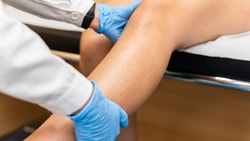Thessaly Test Explained: Technique, Accuracy, and When to Use It
February 13, 2025
3 min. read

Understanding the Thessaly Test
The Thessaly test is a widely recognized clinical assessment used to evaluate potential meniscal injuries in the knee. Healthcare providers utilize this test to identify damage to the medial or lateral meniscus, providing a quick and non-invasive diagnostic tool. This article will examine the test’s methodology, clinical significance, accuracy, and limitations, offering evidence-based insights for medical professionals.
Free Meniscus Injury Exercises PDF
Fill out the form to unlock your free Free Meniscus Injury Exercises PDF!
Unlock Resource
How the Thessaly Test Works
Performing the Test
The Thessaly test is conducted with the patient standing on one leg while slightly flexing the knee. The clinician guides the patient through a series of rotational movements to assess for pain or mechanical symptoms. The standard procedure includes:
The patient stands on the test leg while holding onto the clinician for balance.
The knee is flexed to approximately 5 degrees, and the patient rotates their body three times in each direction.
The test is repeated with the knee flexed to 20 degrees.
A positive result is indicated by joint-line discomfort or a locking sensation.
Clinical Relevance
Meniscal injuries are common among athletes and active individuals, often resulting from twisting motions or direct trauma. The Thessaly test offers a quick method to screen for these injuries, aiding clinicians in making informed decisions about further imaging or treatment options.
Accuracy and Reliability of the Thessaly Test
Sensitivity and Specificity
Studies have examined the Thessaly test’s diagnostic performance, reporting varying sensitivity and specificity rates. Research suggests:
Sensitivity ranges between 66% and 89%.
Specificity varies from 91% to 96%.
These figures indicate that while the Thessaly test is a useful screening tool, it should be used in conjunction with other clinical assessments and imaging when necessary.
Comparison With Other Meniscal Tests
Other clinical assessments, such as McMurray’s and Apley’s tests, have traditionally been used to detect meniscal injuries. While these tests remain valuable, the Thessaly test provides a functional, weight-bearing alternative that mimics real-life movements, potentially increasing diagnostic accuracy.
Limitations and Considerations
Potential Pitfalls
While the Thessaly test is beneficial, there are factors that may impact its reliability:
Patients with acute pain may struggle to perform the test, leading to inconclusive results.
Individuals with balance impairments may find it challenging to complete the rotational movements.
False positives can occur due to concurrent knee pathologies, such as ligamentous injuries or osteoarthritis.
Best Practices for Clinicians
To improve the accuracy of the Thessaly test:
Educate patients on proper movement mechanics during testing.
Use additional assessments to corroborate findings.
Consider patient history and presenting symptoms when interpreting results.
The Thessaly test is a valuable tool for identifying meniscal injuries, offering a functional and efficient assessment method. While it provides high specificity, it is most effective when combined with other diagnostic approaches. Healthcare providers should be aware of its limitations and apply clinical judgment to enhance diagnostic accuracy. By integrating this test into routine evaluations, clinicians can improve early detection and guide appropriate treatment strategies for patients with knee injuries.
Explore More Evidence-Based Orthopedic Exams
The Thessaly Test is just one of many tools available to help clinicians diagnose and manage musculoskeletal conditions with greater precision. At Medbridge, we equip providers with the knowledge and resources they need to elevate care—from exam technique to evidence-informed decision-making.
Ready to enhance your orthopedic assessment skills?
Subscribe today to unlock full access to our comprehensive library of orthopedic special tests, including video demonstrations, clinical pearls, and expert-led guidance to support confident diagnosis and effective treatment planning.
To continue building your clinical expertise, visit our PT CEU page for in-depth courses, certifications, and guided learning paths.





